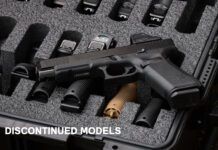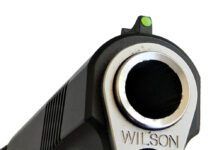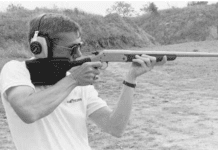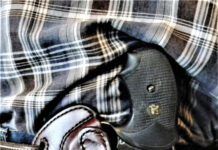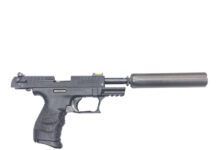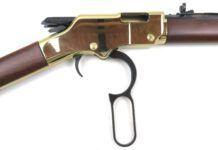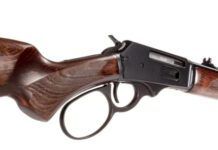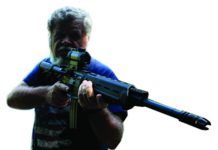Deer rifle. Cowboy gun. Saddle carbine. The .30-30 lever-action rifle is well known, no matter what you call it. Whether you want a knock-about rifle for hanging in the back window of your pickup, slinging under your foot on a snowmobile, or to use for the serious work of knocking down your yearly supply of venison, the .30-caliber lever rifle is one handy tool.
Where does it shine? Actually, the lever-action rifle doesn’t really shine for much of anything, truth be told. Normally, today’s lever rifle isn’t known as a tack driver, but there are exceptions. Neither is the .30-30 an overwhelming powerhouse. Lever rifles tend to be reliable and, above all, handy. They’re slimmer by far than a bolt-action rifle, and thus fit onto a horse better. They hold a bit more ammunition than the average bolt rifle, but of course we all need only one shot for all our hunting, right?
The lever-action .30-30 is commonly a relatively small and light piece that will be there, no matter what. That’s sort of the domain of the handgun, but handguns take lots of practice to shoot well, and many of us just don’t have the time to learn. Anyway, the .30-30 is more powerful than most handguns, and hits come a whole lot easier with any two-hand gun than with a handgun.
The Guns
We chose a pair of Marlins and a pair of Winchesters for this test. They were the Marlin Models 30 AW and 336 CS, and two Winchester Model 94s in Ranger and Legacy versions. The Marlin 336 CS and the Winchester 94 Legacy had walnut stocks. The other two rifles had walnut-stained hardwood stocks, birch in the case of the Marlin 30 AW. All the stocks had a satin finish.
All the test rifles had 20-inch barrels. They all had a 13-5/8 length of pull except the Marlin 30 AW, which measured 13 3/8 inches. All the rifles held six rounds in their tubular magazines, plus one in the chamber if you are so inclined. They all featured blued finishes, and that’s about where the similarities ended. Note: Flat-point ammunition is mandatory for use in tubular magazines. One must avoid the sharp nose of one cartridge pressing against the primer of the one in front of it. Detonations have happened.
The pair of Marlins both had the edges of the receiver finished in a matte blue, while the remainder was shiny blue. Both had white bolts, lightly polished. The Marlin 30 AW had pressed-in checkering, while its slightly more costly brother with the American black walnut stock, the 336 CS, sported cut checkering that was quite well done. Both versions had blued steel swivel studs. The 30 AW had a black plastic buttplate, quite well installed. The 336 CS had a black and a white spacer between the walnut butt and a brown rubber recoil pad, and the plastic pistol grip cap was set off with a white spacer.
[PDFCAP(1)].[PDFCAP(2)].
Our two Winchesters, like the Marlins, were of all-steel construction. All the major components had a blued finish with medium polish to the parts. All Winchester Model 94 rifles were, of course, top-ejection, while the Marlins had ejection ports exiting the receivers to the right. The slightly less costly Winchester Ranger, with its stained hardwood stock, had no checkering nor any sling swivels. It did have a black buttplate that was very well installed. The Legacy version, however, had cut checkering on its walnut stock and it was a good job, sharp and neatly done. It also had a black plastic buttplate very expertly installed. Again, however, no sling swivels or studs were provided. The Legacy had a pistol grip, while the Ranger had the 94’s traditional straight grip.
[PDFCAP(3)].[PDFCAP(4)].
Sights
The Marlin 30 AW had a front blade with brass bead, dovetailed directly into the barrel. Its higher grade brother, the 336 CS, had a similar brass-colored bead/blade front, dovetailed into a ramp attached to the barrel, and the sight was protected with a hood. For rear sights, the 30 AW had a bent steel piece with U-notch, step-adjustable for elevation and driftable for windage. This setup provided a slightly fuzzy sight picture. The 336 CS had a semi-buckhorn rear with U-notch, again step-adjustable for elevation and driftable for windage. This setup provided a satisfactory sight picture. The receivers of both Marlins were drilled and tapped for scope mounting. Each Marlin came with an offset clamp-on thumbpiece for easier hammer cocking when the rifle is fitted with a scope.
Both Winchesters had identical sighting systems. They consisted of a bead-top front blade dovetailed into the barrel, and a semi-buckhorn rear blade with a U-notch and a white triangle underneath that. Like the Marlins’ sights, the rear sights on the Winchesters are step-adjustable for elevation and driftable for windage. This system, though crude, has provided adequate sight adjustment on a great variety of rifles for well over 100 years. On the test Winchesters, the sight picture was clean, but the front sight didn’t stand out very well. The Winchesters’ receivers were also drilled and tapped for scope mounting. Each came with a hammer extension that screws into a hole in the hammer spur.
Safeties
Each Marlin had a crossbolt safety located at the rear of the receiver that was engaged by pressing it to the right. When engaged, it prevented the hammer from hitting the firing pin. The hammer had to be partially retracted to either engage or disengage this safety device.
The Winchesters also had a crossbolt safety located at the rear of the receiver. Sliding it to the right engaged it, and that blocked the hammer from hitting the firing pin. The hammer didn’t need to be retracted to operate this safety.
We can only wonder at the presence of such safeties on hammer rifles. Long gone are the days when all rifles had hammers with safety notches, and the common knowledge of safe operation of the hammers, usually learned when a child, is apparently gone with them.
Triggers
The pull of the Marlin 30 AW was the lightest of the test, and the bad news is that it released at 6-1/4 pounds. In our opinion, this was more than two pounds too heavy. There was 3/16-inch of slack, a crisp release and moderate overtravel. The pull of the 336 CS weighed a full 7 pounds. It had 3/16-inch of slack, released cleanly, and had moderate overtravel. The trigger itself was blued, ungrooved, 1/4-inch wide, and had smooth edges. The trigger on the cheaper 30 AW was gold plated, and otherwise matched that of the 336 CS.
The Winchesters kept up the test Marlin’s tradition that the more you pay for the rifle, the heavier was the trigger pull. The Ranger had a 6-3/4 pounder, with a full 5/16-inch of slack. It also had minor creep and moderate overtravel. The ungrooved blued trigger itself was 1/4-inch wide with slightly uncomfortable squared edges. Its big brother, the Legacy, had a hefty 7-pound trigger pull. It had 3/8-inch of slack and moderate overtravel. The trigger itself was a duplicate of that on the Ranger.
Fit and Finish
We felt the stock-to-metal fit on the Marlin 30 AW was only average. There was a small gap along the right side of the barrel and forend. There were very small gaps between the upper and lower tangs of the receiver and the wood. In contrast, the Marlin 336 CS had very good inletting, with no gaps or high/low spots.
We found the Marlin 30 AW showed minor rub marks on the right side of the hammer. The trigger on both Marlins had a lot of side-to-side play, but other parts had only a small amount of play.
Both Winchesters had only average inletting. There was a medium-size gap between the forend and receiver on the cheaper Ranger, and medium gaps at the rear of the receiver’s upper and lower tangs. These latter, however, really belong there to avoid stock splitting as the rifle sets back into the stock with time and lots of shooting. The more costly Legacy had these rear-tang gaps also, plus a bit of gap between the rear of the forend and the front of the receiver.
Both Winchesters had minor tool marks on the sides of the bolt, but the bolts locked up securely. Other moving parts had moderate play.
Handling & Shooting
The Marlins each weighed 7 pounds. This gave them a somewhat more sluggish feel than either of the Winchester 94s, which weighed 6-1/4 pounds for the Ranger and 6-1/2 for the Legacy. The Marlin 30 AW was a little less muzzle-heavy than the 336 CS, but more so than either Model 94. We found shouldering of the 30 AW to be the least natural of the test, as was target acquisition. The buttplate was uncomfortable because of the shape of the toe, and it slipped all over our shoulders. We also thought the pistol grip was too bulky, but it did give a good grasp on the rifle. Quite naturally, the 30 AW gave less felt recoil than the Winchesters, but more than the slightly heavier 336 CS. The cheeking (cheek-to-stock fit) was not quite as comfortable as that of the 336, but was satisfactory.
Shouldering the Marlin 336 CS was smooth, but not as fast as the Winchester 94. Target acquisition was more than satisfactory. The rubber recoil pad was the most comfortable and most non-slip of the entire test. The wide comb of this rifle also gave the most stable and comfortable cheeking of the test. The pistol grip was hand-filling and comfortable. It, together with a well-shaped forend, allowed good control of the rifle.
Both Winchester buttplates were relatively comfortable and non-slip. We found the shouldering and target acquisition of the Ranger to be fast, but not quite as fast or natural as that of the Legacy because of the latter’s pistol grip. Most shooters didn’t especially like the straight grip. We guess they weren’t raised in the saddle, like the cowboys of yore. Be that as it may, the slim forend and comparatively thin combs of both Winchesters afforded a secure cheeking with a good view of the iron sights. The Ranger gave the most felt recoil of all the guns tested, but it wasn’t what we could call excessive. The .30-30 just isn’t all that powerful.
Loading and cycling the actions of these rifles proved instructive. The rounds inserted readily into both of the Marlins. The actions of the two Marlins cycled much easier than those of the Winchesters, and the 336 CS was the smoothest of all. We found it very difficult to load the tubular magazines of the Winchesters because the cartridge rims hung up on the front edge of the loading port in the side of the receiver. We had to push hard to fully insert each round. Cycling the action of the 94 Legacy was not nearly as easy or smooth as either of the Marlins, but much smoother than that of the 94 Ranger. The Ranger’s lever actually stuck during the initial stages of the return travel when closing the action.
We test-fired the rifles with Winchester 150-grain PP SP, Remington 160-grain ER SP, and with Federal 170-grain SP RN ammunition. With the lightest bullets, the Marlin 30 AW and the 94 Legacy were a dead heat, with 1.5-inch average groups at 50 yards. With the Remington 160-grainers, the 30 AW pulled ahead, but not by much. The Marlin shot them into 1.6 inches and the Winchester into 1.9. With the heaviest tested bullets, the 170-grain Federal load, groups for these two best-shooting of the test rifles were 1.9 inches for the Marlin and 2.0 for the Winchester Legacy. Pretty much a toss-up.
[PDFCAP(5)].Of the other two test rifles, the worst shooting gun of the bunch was the 94 Ranger, and its worst group was 2.3 inches with the heaviest-bullet loads. Our shooters felt that was acceptable for the kind of uses for which the rifle was designed, but we’d like more accuracy than that. The Ranger’s best groups were 2.2 inches average, with the 150-grain Winchester ammo. The Marlin 336 was not far off its cheaper brother for all groups fired, actually just a bit worse than the Winchester 94 Legacy. In fact, with two weights of ammo, the accuracy of the Legacy was identical to that of the 336 CS.
There were no malfunctions with any of the rifles. The two Winchesters feature their angle-ejection, flinging cases upward to the right. We noted the Marlins had a bit smoother extraction than the Winchesters.
Our Picks
Our shooters liked the feel of the Winchester 94 Legacy better than that of the Ranger. We were repelled by the rough action of the Ranger, so pretty much ruled it out of contention here, unless we were willing to undertake some gunsmithing expenses to slick it up. However, the Ranger was cheapest at $320 of all guns in the test, and lightest to boot, being a full 3/4-pound lighter than either Marlin and 1/4-pound lighter than the Legacy. Therefore, some gunsmithing might be a reasonable thing to consider, especially if you want the lightest lever .30-30. Nonetheless, we’d pick the Legacy over the Ranger.
We preferred the speed of handling of the Legacy over that of the Marlins. However, we preferred the smooth feeding and operation of the Marlins over the Winchesters. The Marlins look more massive than the Winchesters because of the lever design. They do weigh half a pound more, and that might not be a price you’re willing to pay.
The Winchester 94 Legacy as tested cost $393. The lowest-price Marlin cost a buck less, $392, and gave us the best accuracy. If you want the walnut stock, cut checkering, white-line spacers and hooded front sight of the Marlin 336 CS, you’d have to shell out $459. Frankly, we thought that was too much money for extras that don’t really do anything for performance. We like walnut, but not the way this one was gussied up. In case you haven’t figured it out yet, we’d put our money into the Marlin 30 AW.


